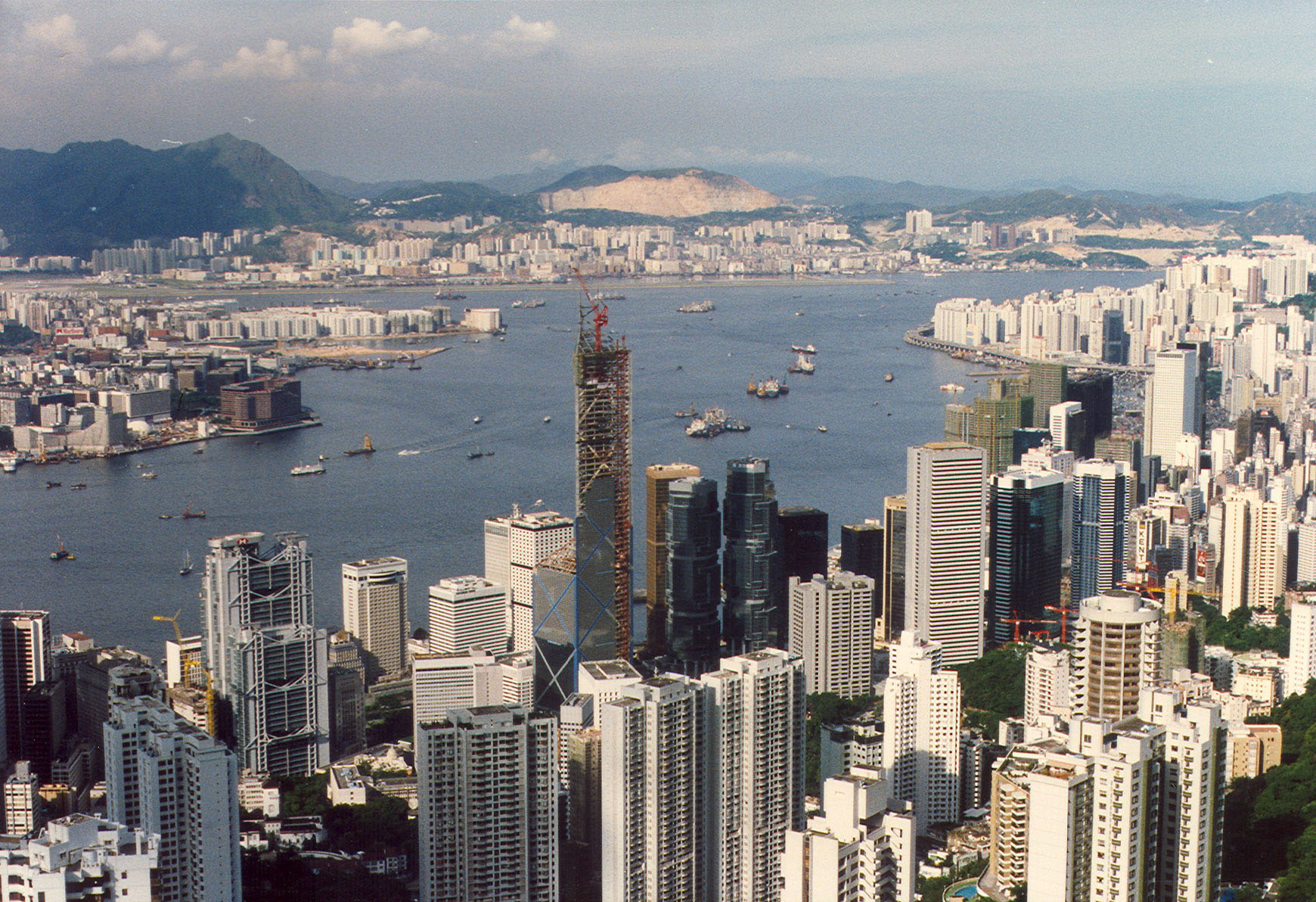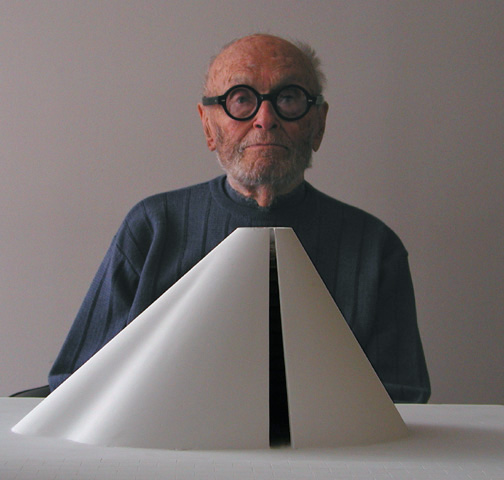|
Bank Of China Tower (Hong Kong)
The Bank of China Tower (BOC Tower) is a skyscraper located in Central, Hong Kong. Located at 1 Garden Road on Hong Kong Island, the tower houses the headquarters of the Bank of China (Hong Kong) Limited. One of the most recognisable landmarks in Hong Kong, the building is notable for its distinct shape and design, consisting of triangular frameworks covered by glass curtain walls. The building was designed by Chinese-American architect I. M. Pei and L.C Pei of I.M Pei and Partners. At a height of , reaching high including a spire, the building is the fourth tallest skyscraper in Hong Kong, after International Commerce Centre, Two International Finance Centre and Central Plaza. It was the tallest building in Hong Kong and Asia from 1989 to 1992, and it was the first supertall skyscraper outside the United States, the first to break the 305 m (1,000 ft) mark. It was surpassed by Central Plaza on the same island in 1992. Construction began on 18 April 1985 o ... [...More Info...] [...Related Items...] OR: [Wikipedia] [Google] [Baidu] |
Garden Road, Hong Kong
Garden Road is a major road on Hong Kong Island, Hong Kong, connecting the Central and Mid-Levels areas. It was formerly known as Albany Nullah. At its lower (Central) end, Garden Road forms a grade-separated intersection with Queensway. For most of its length, Garden Road carries traffic only in the downhill direction. Uphill traffic is carried by Cotton Tree Drive, parallel to and to the east of Garden Road. Cotton Tree Drive merges with Garden Road just above the intersection with Upper Albert Road, and Garden Road continues uphill to an intersection with Robinson Road and Magazine Gap Road in the Mid-Levels. Garden Road is rich in historical and heritage value. The Bank of China Tower, Three Garden Road, St. John's Cathedral, St. John's Building, the Helena May main building, the lower terminus of the Peak Tram, the United States Consulate-General, and the Hong Kong Zoological and Botanical Gardens all lie on the road. In November 1841, the land between Garden and ... [...More Info...] [...Related Items...] OR: [Wikipedia] [Google] [Baidu] |
Handover Of Hong Kong
Sovereignty of Hong Kong was transferred from the United Kingdom to the People's Republic of China (PRC) at midnight on 1 July 1997. This event ended 156 years of British rule in the former colony. Hong Kong was established as a special administrative region of China (SAR) for 50 years, maintaining its own economic and governing systems from those of mainland China during this time, although influence from the central government in Beijing increased after the passing of the Hong Kong national security law in 2020. Hong Kong had been a colony of the British Empire since 1841, except for four years of Japanese occupation from 1941 to 1945. After the First Opium War, its territory was expanded on two occasions; in 1860 with the addition of Kowloon Peninsula and Stonecutters Island, and again in 1898, when Britain obtained a 99-year lease for the New Territories. The date of the handover in 1997 marked the end of this lease. The 1984 Sino-British Joint Declaration had set th ... [...More Info...] [...Related Items...] OR: [Wikipedia] [Google] [Baidu] |
Space Frame
In architecture and structural engineering, a space frame or space structure ( 3D truss) is a rigid, lightweight, truss-like structure constructed from interlocking struts in a geometric pattern. Space frames can be used to span large areas with few interior supports. Like the truss, a space frame is strong because of the inherent rigidity of the triangle; flexing loads (bending moments) are transmitted as tension and compression loads along the length of each strut. History Alexander Graham Bell from 1898 to 1908 developed space frames based on tetrahedral geometry. Bell's interest was primarily in using them to make rigid frames for nautical and aeronautical engineering, with the tetrahedral truss being one of his inventions. Max Mengeringhausen developed the space grid system called MERO (acronym of ''MEngeringhausen ROhrbauweise'') in 1943 in Germany, thus initiating the use of space trusses in architecture. The commonly used method, still in use has individual tubu ... [...More Info...] [...Related Items...] OR: [Wikipedia] [Google] [Baidu] |
Pritzker Architecture Prize
The Pritzker Architecture Prize is an international architecture award presented annually "to honor a living architect or architects whose built work demonstrates a combination of those qualities of talent, vision and commitment, which has produced consistent and significant contributions to humanity and the built environment through the art of architecture.” Founded in 1979 by Jay A. Pritzker and his wife Cindy, the award is funded by the Pritzker family and sponsored by the Hyatt Foundation. It is considered to be one of the world's premier architecture prizes, and is often referred to as the Nobel Prize of architecture. The Pritzker Architecture Prize is said to be awarded "irrespective of nationality, race, creed, or ideology". The recipients receive US$100,000, a citation certificate, and, since 1987, a bronze medallion. The designs on the medal are inspired by the work of architect Louis Sullivan, while the Latin inspired inscription on the reverse of the medallion— ... [...More Info...] [...Related Items...] OR: [Wikipedia] [Google] [Baidu] |
Bank Of China Tower Massing Model
A bank is a financial institution that accepts deposits from the public and creates a demand deposit while simultaneously making loans. Lending activities can be directly performed by the bank or indirectly through capital markets. Because banks play an important role in financial stability and the economy of a country, most jurisdictions exercise a high degree of regulation over banks. Most countries have institutionalized a system known as fractional reserve banking, under which banks hold liquid assets equal to only a portion of their current liabilities. In addition to other regulations intended to ensure liquidity, banks are generally subject to minimum capital requirements based on an international set of capital standards, the Basel Accords. Banking in its modern sense evolved in the fourteenth century in the prosperous cities of Renaissance Italy but in many ways functioned as a continuation of ideas and concepts of credit and lending that had their roots in the anc ... [...More Info...] [...Related Items...] OR: [Wikipedia] [Google] [Baidu] |
Numbers In Chinese Culture
Some numbers are believed by some to be auspicious or lucky (吉利, ) or inauspicious or unlucky (不吉, ) based on the Chinese word that the number sounds similar to. The numbers 3, 6, and 8 are generally considered to be lucky, while 4 is considered unlucky. These traditions are not unique to Chinese culture, with other countries with a history of Han characters also having similar beliefs stemming from these concepts. Zero The number 0 (零, ) is the beginning of all things and is generally considered a good number, because it sounds like 良 (pinyin: ''liáng''), which means 'good'. One The number 1 (一, ) is neither auspicious nor inauspicious. It is a number given to winners to indicate the first place. But it can also symbolize loneliness or being single. For example: November 11 is the Singles' Day in China, as the date has four ‘1’ which stand for singles. Two The number 2 (二, cardinal, or 兩, used with units, ) is most often considered a good number i ... [...More Info...] [...Related Items...] OR: [Wikipedia] [Google] [Baidu] |
Far Eastern Economic Review
The ''Far Eastern Economic Review'' (''FEER'') was an Asian business magazine published between 1946 and December 2009 in the English language. Based in Hong Kong, the news magazine published weekly until December 2004, when it converted to a monthly publication because of financial difficulties. After ''FEER'' became a monthly, most articles were contributed by non-staff specialists, including economists, business-community figures, government policymakers and social scientists. ''FEER'' covered a variety of topics including politics, business, economics, technology, and social and cultural issues throughout Asia, focusing on Southeast Asia and Greater China. History The ''Far Eastern Economic Review'' was started in 1946 by Eric Halpern, a Jewish immigrant from Vienna. He initially settled in Shanghai and worked for ''Finance and Commerce'', a biweekly business magazine that shut down in December 1941 after Japanese troops invaded the city. The Kadoorie family, Jardines, ... [...More Info...] [...Related Items...] OR: [Wikipedia] [Google] [Baidu] |
Beijing
} Beijing ( ; ; ), alternatively romanized as Peking ( ), is the capital of the People's Republic of China. It is the center of power and development of the country. Beijing is the world's most populous national capital city, with over 21 million residents. It has an administrative area of , the third in the country after Guangzhou and Shanghai. It is located in Northern China, and is governed as a municipality under the direct administration of the State Council with 16 urban, suburban, and rural districts.Figures based on 2006 statistics published in 2007 National Statistical Yearbook of China and available online at archive. Retrieved 21 April 2009. Beijing is mostly surrounded by Hebei Province with the exception of neighboring Tianjin to the southeast; together, the three divisions form the Jingjinji megalopolis and the national capital region of China. Beijing is a global city and one of the world's leading centres for culture, diplomacy, politics, finance, busine ... [...More Info...] [...Related Items...] OR: [Wikipedia] [Google] [Baidu] |
1989 Tiananmen Square Protests
The Tiananmen Square protests, known in Chinese as the June Fourth Incident (), were student-led demonstrations held in Tiananmen Square, Beijing during 1989. In what is known as the Tiananmen Square Massacre, or in Chinese the June Fourth Clearing () or June Fourth Massacre (), troops armed with assault rifles and accompanied by tanks fired at the demonstrators and those trying to block the military's advance into Tiananmen Square. The protests started on 15 April and were forcibly suppressed on 4 June when the government declared martial law and sent the People's Liberation Army to occupy parts of central Beijing. Estimates of the death toll vary from several hundred to several thousand, with thousands more wounded. The popular national movement inspired by the Beijing protests is sometimes called the '89 Democracy Movement () or the Tiananmen Square Incident (). The protests were precipitated by the death of pro-reform Chinese Communist Party (CCP) general secretary Hu ... [...More Info...] [...Related Items...] OR: [Wikipedia] [Google] [Baidu] |
Kumagai Gumi
is a Japanese construction company founded in Fukui, Fukui Prefecture, Japan. The company still has registered headquarters in Fukui, but the actual head office is located in Shinjuku, Tokyo. History Santaro Kumagai, the company's founder, began his career as a civil servant in a police department. His construction career started as a stonemason, crafting religious monuments and performing work for the expanding railway network. Kumagai founded his own company in 1898 and incorporated it in 1938. Between 1955 and 1983 the company accounted for more than 10% of all contracts awarded to the fifty-seven members of the Overseas Construction Association of Japan, a figure that outranked the ‘Big Five’ domestic giant construction companies. As overseas projects were riskier, these five companies were reluctant to expand beyond Japan. Kumagai Gumi took advantage of the situation and sought work overseas, as both as a construction company and a developer, using BOT as project fina ... [...More Info...] [...Related Items...] OR: [Wikipedia] [Google] [Baidu] |





.jpg)